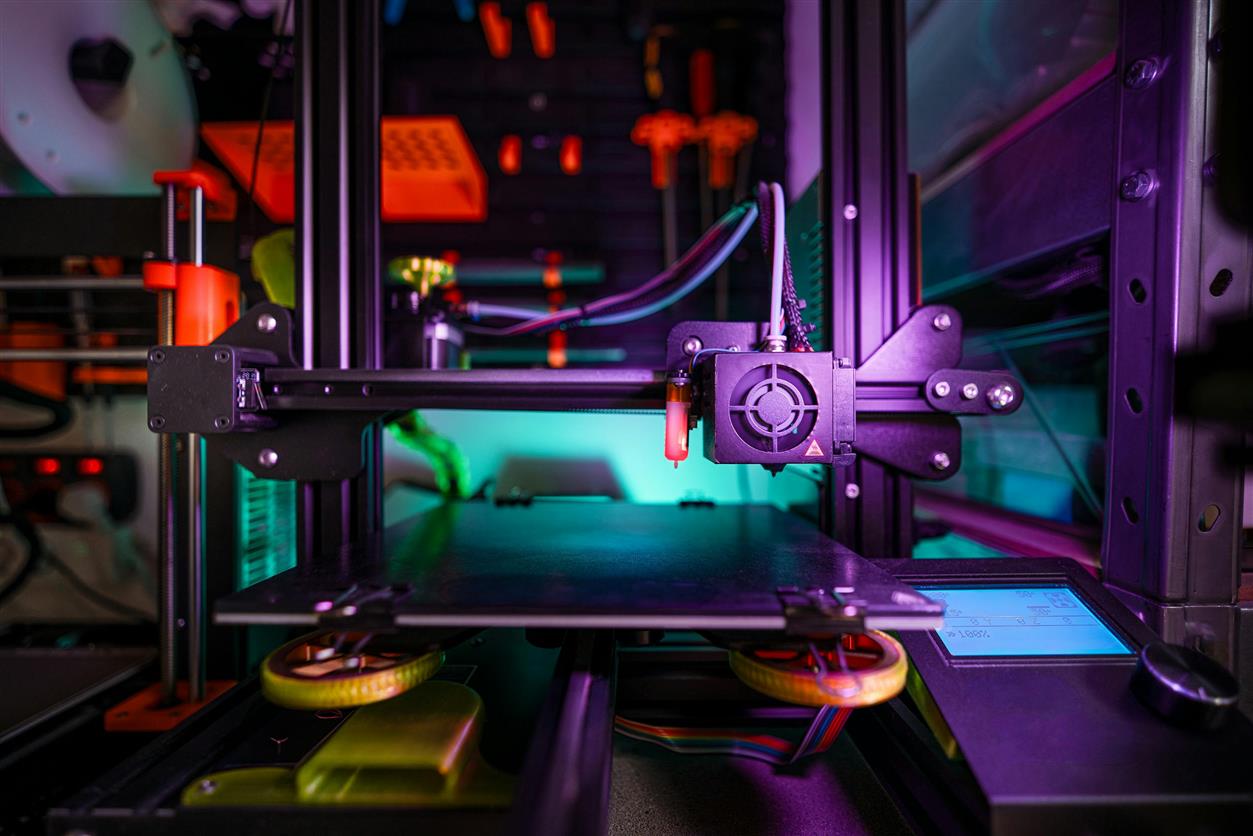
Introduction
3D printing, also known as additive manufacturing, has emerged as one of the most transformative technologies of the 21st century. Initially conceived in the 1980s, 3D printing has evolved from a niche technology into a revolutionary force in manufacturing and design. This essay explores how 3D printing is reshaping these fields, examining its impact on traditional manufacturing processes, its influence on design practices, and its future potential.
Understanding 3D Printing Technology
1. Basic Principles
3D printing involves creating three-dimensional objects from digital models by adding material layer by layer. This contrasts with traditional subtractive manufacturing, where material is removed from a larger block. Key steps in the 3D printing process include:
- Design Creation: A digital model of the object is created using Computer-Aided Design (CAD) software.
- Slicing: The digital model is sliced into thin layers using slicing software, which generates instructions for the 3D printer.
- Printing: The 3D printer deposits material layer by layer according to the instructions, building the object from the bottom up.
- Post-Processing: After printing, the object may undergo additional finishing processes, such as sanding or painting.
2. Types of 3D Printing Technologies
Various 3D printing technologies are used, each with its own advantages and applications:
- Fused Deposition Modeling (FDM): FDM printers melt thermoplastic filaments and extrude them through a nozzle. Commonly used for prototyping and low-cost production.
- Stereolithography (SLA): SLA uses ultraviolet light to cure resin in a liquid vat, creating high-resolution parts with smooth surfaces.
- Selective Laser Sintering (SLS): SLS uses a laser to fuse powdered materials together, suitable for creating complex and durable parts.
- Digital Light Processing (DLP): Similar to SLA, DLP uses a projector to cure resin but with a faster printing speed due to the use of a digital light source.
The Impact of 3D Printing on Manufacturing
1. Reducing Manufacturing Costs
3D printing is transforming cost structures in manufacturing:
- Lower Production Costs: By eliminating the need for expensive molds and tooling, 3D printing reduces initial production costs. This is particularly advantageous for small production runs and custom products.
- On-Demand Production: 3D printing enables on-demand production, reducing inventory costs and minimizing waste. Manufacturers can produce items as needed, avoiding overproduction and storage expenses.
2. Enhancing Customization and Personalization
Customization and personalization have become more accessible with 3D printing:
- Tailored Products: Manufacturers can produce customized products based on individual specifications. Examples include bespoke medical implants, custom-fit footwear, and personalized consumer goods.
- Rapid Prototyping: Designers can quickly create and test prototypes, iterating designs based on feedback without the need for expensive retooling. This accelerates the development process and fosters innovation.
3. Streamlining Supply Chains
3D printing is revolutionizing supply chain management:
- Local Manufacturing: By enabling local production, 3D printing reduces reliance on global supply chains. This is particularly beneficial for industries facing supply chain disruptions or seeking to reduce transportation costs.
- Spare Parts Production: Manufacturers can produce spare parts on demand, reducing the need for large inventories and minimizing downtime for machinery and equipment.
4. Enabling Complex Geometries and Lightweight Structures
3D printing allows for the creation of complex geometries and lightweight structures:
- Complex Designs: Traditional manufacturing methods often struggle with intricate designs due to limitations in tooling and machining. 3D printing can produce complex geometries that would be difficult or impossible to achieve otherwise.
- Lightweight Components: 3D printing enables the creation of lightweight structures with optimized material usage. This is particularly advantageous in industries like aerospace, where reducing weight can lead to significant cost savings and performance improvements.
The Impact of 3D Printing on Design
1. Transforming Design Processes
3D printing is reshaping the design process:
- Rapid Iteration: Designers can quickly iterate on their designs by creating physical prototypes almost instantly. This accelerates the design process and allows for more experimentation and refinement.
- Enhanced Creativity: The freedom to create complex and unconventional shapes fosters innovation. Designers can explore new forms and structures that were previously constrained by traditional manufacturing methods.
2. Empowering Individuals and Small Businesses
3D printing democratizes design and manufacturing:
- Accessible Design Tools: With affordable 3D printers and user-friendly design software, individuals and small businesses can bring their ideas to life without needing access to industrial-scale manufacturing facilities.
- Entrepreneurial Opportunities: Small businesses and startups can enter markets with low upfront costs, leveraging 3D printing to produce niche products and prototypes without the need for large-scale production.
3. Changing Product Development Cycles
3D printing accelerates product development:
- Faster Time-to-Market: The ability to quickly produce and test prototypes reduces the time required to bring new products to market. This is especially valuable in industries where speed and responsiveness are crucial.
- Iterative Design: Designers can rapidly test and refine their products, incorporating feedback and making adjustments with minimal delays. This iterative approach leads to better-designed products and more successful market outcomes.
Real-World Applications and Case Studies
1. Medical Industry
3D printing has made significant advancements in the medical field:
- Customized Implants and Prosthetics: 3D printing allows for the production of custom-fit implants and prosthetics tailored to individual patients’ needs. For example, orthopedic implants and dental crowns can be designed with precise measurements for optimal fit and functionality.
- Bioprinting: Researchers are exploring the potential of bioprinting to create tissue and organ structures. While still in the experimental stages, bioprinting holds promise for future medical treatments and regenerative medicine.
2. Automotive Industry
The automotive industry benefits from 3D printing in various ways:
- Rapid Prototyping: Automotive manufacturers use 3D printing to create prototypes of parts and components quickly. This accelerates the development of new vehicle models and allows for rapid design iteration.
- Customized Parts: 3D printing enables the production of custom parts and accessories for vehicles. This includes everything from bespoke interior components to lightweight performance parts.
3. Aerospace Industry
The aerospace industry leverages 3D printing for its unique benefits:
- Lightweight Components: Aerospace manufacturers use 3D printing to produce lightweight parts with complex geometries, leading to fuel efficiency and performance improvements.
- On-Demand Production: 3D printing allows for the on-demand production of spare parts and components, reducing inventory costs and streamlining maintenance operations.
Challenges and Limitations
Despite its numerous advantages, 3D printing faces challenges and limitations:
1. Material Limitations
While 3D printing technology has advanced significantly, the range of printable materials remains limited compared to traditional manufacturing methods. Researchers are continually working to expand the materials available for 3D printing, but challenges such as material strength, durability, and cost persist.
2. Speed and Scalability
While 3D printing excels at rapid prototyping and small-batch production, it can be slower compared to traditional manufacturing methods for large-scale production. The speed of 3D printing is improving, but scalability remains a concern for high-volume manufacturing.
3. Cost of Equipment
High-quality 3D printers and materials can be expensive, particularly for industrial-grade machines. The initial investment can be a barrier for some businesses and individuals, though costs are decreasing as technology advances.
4. Intellectual Property Concerns
The digital nature of 3D printing raises concerns about intellectual property and counterfeiting. With the ability to easily replicate digital designs, protecting intellectual property and preventing unauthorized reproduction is a significant challenge.
Future Trends and Potential
1. Advancements in Materials
Future developments in 3D printing will focus on expanding the range of materials available, including advanced polymers, metals, and composite materials. Innovations in material science will enable new applications and improve the performance of 3D-printed parts.
2. Integration with Other Technologies
3D printing will increasingly integrate with other technologies such as artificial intelligence (AI), robotics, and the Internet of Things (IoT). These integrations will enhance automation, optimize production processes, and enable more sophisticated design and manufacturing capabilities.
3. Sustainability and Recycling
Sustainability will become a key focus for 3D printing, with efforts to develop eco-friendly materials and recycling processes. The ability to use recycled materials and reduce waste will contribute to a more sustainable manufacturing ecosystem.
4. Widespread Adoption
As 3D printing technology continues to advance, it will see broader adoption across various industries and applications. From consumer goods to healthcare and aerospace, 3D printing will play an increasingly important role in shaping the future of manufacturing and design.

Conclusion
3D printing represents a paradigm shift in manufacturing and design, offering unprecedented opportunities for innovation, customization, and efficiency. By enabling the creation of complex geometries, reducing production costs, and empowering individuals and businesses, 3D printing is revolutionizing how products are conceived, designed, and manufactured. While challenges remain, the ongoing advancements in technology and materials promise a bright future for 3D printing, with the potential to transform industries and drive progress in the years to come.










